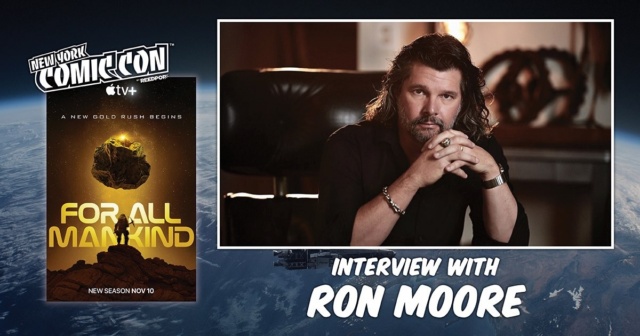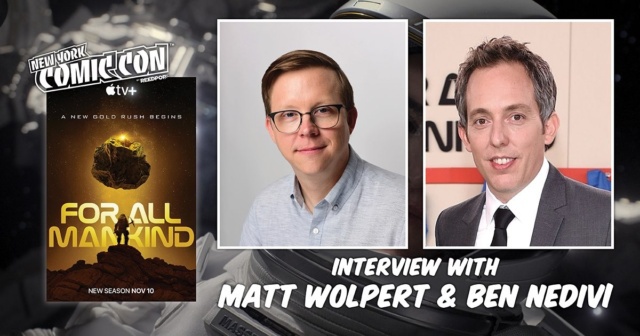NYCC Interview: Garrett Reisman, Seth Reed & Esther Marquis on ‘For All Mankind’ Season 4
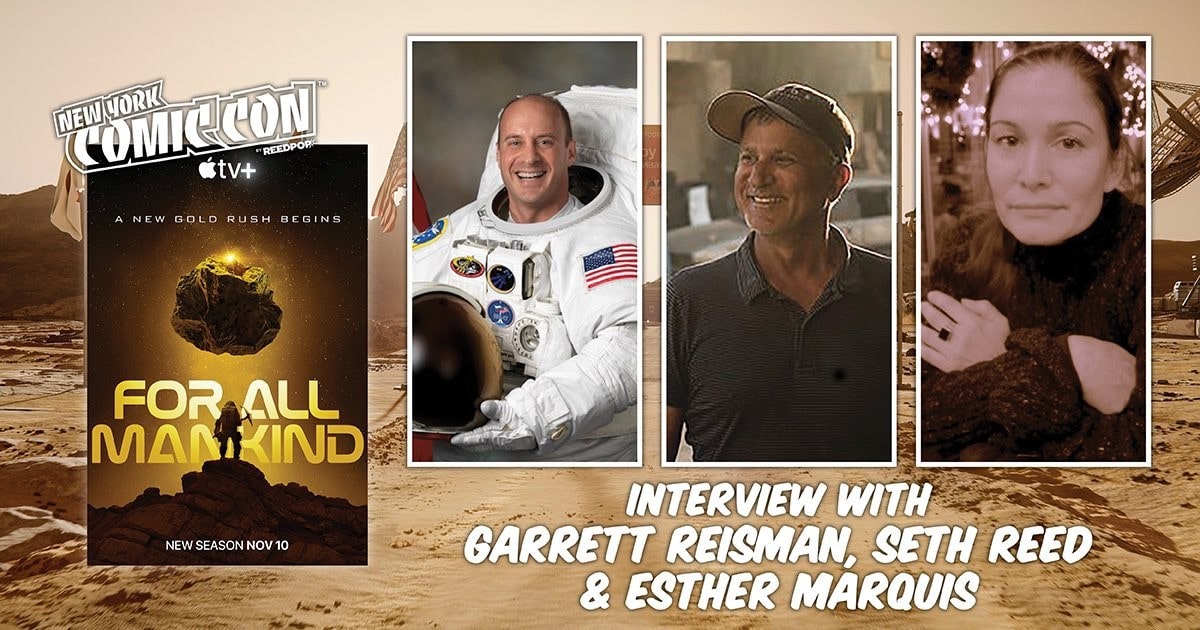
AppleTV+’s For All Mankind is back for a fourth season in November, and the hit sci-fi show had a splashy and exciting early premiere and panel at New York Comic Con this past weekend. The Cosmic Circus sat down with Garrett Reisman, Seth Reed, and Esther Marquis before the panel to get all the details on this season.
Season 4 starts in 2003, and the alternate history of the space race and beyond takes a lot of technical and creative know-how and vision to put together. Garrett Reisman, a former NASA astronaut, is the show’s technical consultant. After a conversation with EP Ronald Moore, he reportedly helped spark the idea for the show itself. Seth Reed is the show’s production designer, and Esther Marquis is the show’s costume designer. These three visionaries, along with other talented folks on the show, have created a visually stunning and believable world that transports viewers to an alternate timeline where space exploration is the norm. (I’d like my base on Mars now, please.)
Returning cast members include Joel Kinnaman, Krys Marshall, Coral Peña, Wrenn Schmidt, Cynthy Wu, and Edi Gathegi. But there are also some exciting and talented newcomers to the world for the new season, including Daniel Stern, Tyner Rushing, and Toby Kebbell.
Over our roundtable interviews at NYCC, we chatted about asteroid physics, how the show came about in the first place, space suits in the show vs real life, and creating the Soviet Union for the show.
The interview with Garrett Reisman, Seth Reed & Esther Marquis on ‘For All Mankind’ season 4
[Editor’s note: This interview has been lightly edited for clarity. There are spoilers ahead for For All Mankind. ]
Interviewer: “So what were the challenges, the main challenges did you see?”
Seth Reed: “That’s a really big general question. Should I start? Because I always start.”
Garrett Reisman: “Okay.”
Seth Reed: “I’m the production designer. My name is Seth Reed. And it’s a science-based sci-fi show, and I’m also going to add a little retro sci-fi as well, or revisionist sci-fi, so that gives us room to exaggerate and to change things, but we’re also very science-based. So everything that you look at, the detail will be real or as real as we can, and then when we change something, it’s a conscious decision, and the audience is part of that.”
“In this season, some storylines have changed, characters have changed. In my world, 96% of the sets were brand new. So it’s basically a brand new… For me, it’s a challenge because we had to greatly expand on everything that you saw in season three. Season three, they were barely on Mars. Now we have two to three hundred people on Mars. We’ve got rovers going every which way. We have a lot of space transportation. And as you’ll see, they’re going to start exploring nearby sources of minerals and energy, like an asteroid they can capture. So that necessitated a redesign in the propulsion systems and necessitated a re-understanding of how you would, because nobody actually exactly knows this, there’s been some theories, how you would capture an asteroid and pull it somewhere or push it somewhere, which we had a whole conversation. Should it be pushed or pulled?”
Garrett Reisman: “Yeah, do you pull or push? That was a major topic of discussion.”
Seth Reed: “Yeah, that was a big discussion.”
Garrett Reisman: “Sure.”
Seth Reed: “So the challenges were gigantic for the season. Very ambitious, very huge season for everybody, with a big department for me, and I’m sure for her, too, gigantic department.”
Esther Marquis: “We have a very big department.”
Garrett Reisman: “By the way, the answer was “push,” and the reason for that… We’re not allowed to give out spoilers, but if you watch, right in episode one, there’s a key plot element that only comes about because you’re pushing, not pulling. Can we say that?”
Seth Reed: “Don’t give it away!”
Garrett Reisman: “I didn’t. I didn’t. Just a key point. I didn’t say what-”
On For All Mankind’s origin and collaboration between the three
Interviewer: “So you are the NASA-”
Garrett Reisman: “Tech consultant, yeah. Former, yeah.”
Interviewer: “When this opportunity presented itself to you, and you’re going to go onto this big studio set as an advisor, helping them make this as realistic as possible, what are some of the thoughts that just start running through your head? Do you want to keep it as authentic and real as possible, or does the little boy in you want to come out and bring out all the dreams you had as a kid and make those come to life on the screen?”
Garrett Reisman: “Well, I get both. So first of all, when Ron first came up with the idea, Ron Moore, for the show, and he had a couple of different competing pitches, and he was trying to figure out which one to do, and I gave him a tour of SpaceX, and we sat down over lunch in the SpaceX restaurant, and when he mentioned this one about an alternate history because another idea was just to do an actual behind-the-scenes history, kind of a Mad Men kind of a thing, and then we mentioned this about, hey, well what would have happened differently if technology kept progressing at the rate at which it was progressing during Apollo?”
Garrett Reisman: “And we took this alternative history where the Russians were first, but their space race didn’t end, and we keep going and keep going. And I was, wow, as a fan, that sounds like such an awesome idea, to see what would have happened.”
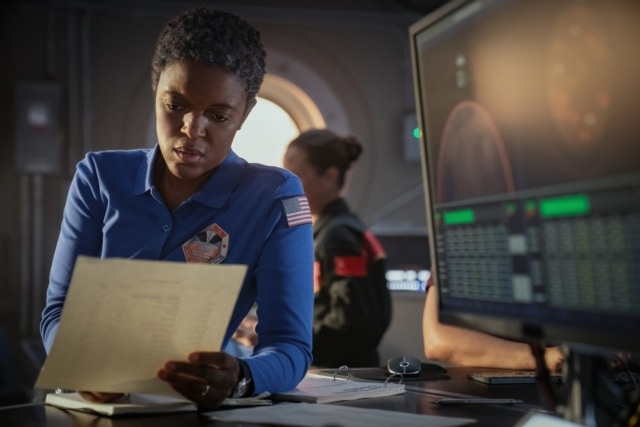
“And so now we’re going off, and now we’re in 2003, in season four, so we still haven’t caught up with real-time, but we have fusion and ion drives, plasma drives, and all this technology that we actually don’t have today in 2023. So that does make it more challenging, because seasons one and two were kind of easy for me, like ‘Well, where’s this thing in the space shuttle?’ I was like, ‘Well, let me pull out my old diagram,’ like, ‘Oh, it’s right here.’ But now Seth comes to me, and he is like, ‘Well, where should the stick be in this?’ I’m like, ‘Well, I don’t know. This thing doesn’t exist,’ this ranger spaceship. It’s like we just made it up, so it could be anywhere.”
Seth Reed: “There’s a lot of times where I would write a letter to Garrett, and Garrett would go like, ‘No, Seth, you don’t have that. We don’t have that.’ And I’d go, ‘What can we do? There’s got to be a way around this.’ So there’s a lot of, between the two of us and maybe also Matt [Wolpert] and Ben [Nedivi], negotiating the decision to make. And in the case of props, they decided there were no cell phones, so maybe you’re going to see a cell phone somewhere, but kind of not so much. And so different things are there and not there. It’s very specifically chosen. And you’ll find that with Esther’s costumes, too. Everything is very specifically figured out. There’s never any randomness on this show.”
On creating spacesuits for For All Mankind
Garrett Reisman: “There’s a lot of discussion. Esther and I had lots of chats about the suit.”
Esther Marquis: “Oh gosh, yes, yeah. And that’s the interesting thing about our show, is that we’re all communicating all the time, exchanging information and sort of weighing up what our options are, and we’re shooting for that realism-”
Seth Reed: “Yeah.”
Esther Marquis: “Even though the things that we’re doing, i.e., a spacesuit design for a Mars surface, hasn’t actually happened. So the job for me was to create this suit that exists in 2003, but it’s not a futuristic suit. It’s a suit that’s squarely sitting in 2003. So we have to believe that that suit would exist in that time, yet it still needed to encompass technology and things that were moving along for our show. So there was a lot of complicated juggling acts that I found myself doing, and I’m sure you did too. Yeah.”
Interviewer: “We’ve seen movies where Martian people visited Mars, and they have their EVA suits, their spacesuits. Did you really want to make this something unique for this show, something that the audience has never seen before?”
Esther Marquis: “Oh, absolutely. As a designer, yes, I think I was… The little ego thing, right? Who wants to do what everybody else has done? But having said that, looking at the historical representations of the spacesuits, going back and looking at absolutely every spacesuit, I went through and studied them. Not only that, I looked at our past spacesuits on the show. I had a great opportunity to interface with those suits, and I was able to sort of make my plan based on what I was seeing, what I was liking, what Matt [Wolpert] and Ben [Nedivi] wanted for the next season, what their expectations were. So there was a lot of design work that went on even before we started building. I think we had two months just on the space suit.”
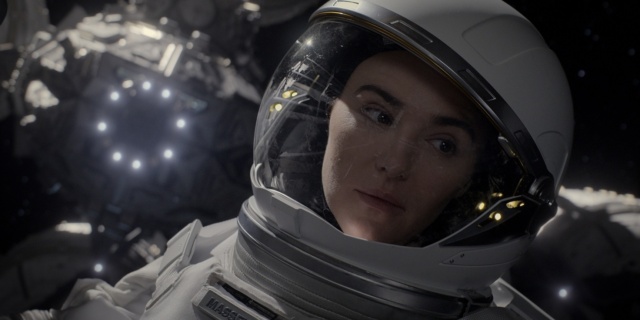
Seth Reed: “I’m going to just say form follows function, of course, very famous architectural expression. And in the case of NASA and the practicality of space flight, that’s even more true. But what’s amazing for both Esther and I is design still comes through. It comes through in a different way than you’re expecting, but it creates, because you’re in outer space under these conditions or you’re on Mars, it creates a whole new set of forms for you to work with.”
Esther Marquis: “That’s very true.”
Garrett Reisman: “I just want to add that Esther’s suits, Mars suits, are way better than the ones that were in The Martian. Hers really kick butt. Yeah, I don’t think there’s any comparison.”
On Ester Marquis’ spacesuits real-life space applications
Ayla Ruby: “You wound up having suits that were used by Axiom too, right, because you had such an expertise?”
Esther Marquis: “Yeah, I’m going to kind of clarify that. Axiom contacted me and asked me to submit a design, a cover design for their space suit. They were making a global news reveal, and the information underneath that cover is highly protected. So I was asked to create a cover. So it was great.”
Garrett Reisman: “Can I interject for just a second?”
Esther Marquis: “Yes, you can.”
Garrett Reisman: “I don’t know if you know this, but actually they, first, they contacted me.”
Esther Marquis: “That’s how they got my email.”
Garrett Reisman: “Yes. They said, ‘Hey, we want to make this cover. Do you know anybody that has talent that could really design something cool?’ And I was like, ‘I know just the person.'”
Seth Reed: “That’s so great.”
Esther Marquis: “I didn’t know that.”
Garrett Reisman: “Oh, and I had the-”
Esther Marquis: “Yeah. The email appeared, and I’m like, oh, how interesting.”
Seth Reed: “‘How did you find me?’ Just kidding.”
Esther Marquis: “But I will tell you that when I got the email, I’m like, oh, first of all, I kind of gasp. I’m like, oh my God, are you serious? And then I thought about the process that I went through working on our space suit, and I’m like, I’m ready to do this. I can do this. And so they were actually soliciting a few things from various people, and they selected mine. And I’m pretty sure, for me, it’s like having that past experience on our show and then designing the most recent suit, I was really in the perfect position to understand what they were asking for. But not only that, they came back and asked me to design their flight suit for their next mission.”
Ayla Ruby: “Oh, cool.”
Garrett Reisman: “That is awesome.”
Esther Marquis: “Yeah, that’s thrilling, because it’s going to be in outer space, not outer space, out, but interior outer space.”
On For All Mankind’s alternate history of 2003
Interviewer: “Back to the 2003 of it all, moving into this new decade, was there anything specific that you were looking forward to, including from the aughts or specifically not including since it’s alternate history, like ‘We won’t do this in our 2000s’?”
Seth Reed: “Looking forward to doing.”
Interviewer: “Sure.”
Seth Reed: “Well, I’m going to say that, I’m going to reiterate a little bit that some things haven’t been invented yet that we built on Mars that haven’t even been done yet, and some things they didn’t want to do. For example, we couldn’t 3-D print anything. A decision was made, even though it’s the early 2000s, no 3-D printing yet. Maybe 10 years later. So when you see the show, some things you identify immediately because culturally they’re part of your current day, and some things are even haven’t been seen yet, like we’re talking about fusion drive for the spaceships and what the spaceships look like, which don’t look like anything you’ve seen before. And then some things are completely retro. Does that answer?”
Interviewer: “Yeah.”
Interviewer: “I wish it was real. We can go back and redo the nineties.”
On filming in Lithuania on For All Mankind season 4
Ayla Ruby: “The no cell phone thing is very interesting to me, but I actually want to bring us down from space a little bit and talk about… I think you went to Lithuania or Bulgaria?”
Seth Reed: “We went to Bulgaria.”
Ayla Ruby: “Bulgaria, I’m sorry.”
Seth Reed: “Yes. Great question.”
Ayla Ruby: “The other big setting for the show.”
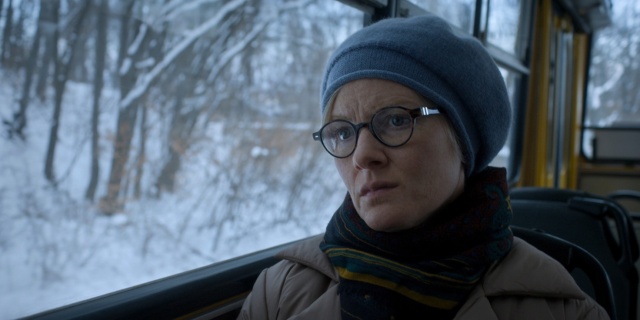
Seth Reed: “So I can’t give away too much of the show, except clearly part of the story takes place in the Soviet Union, which we’ve never explored, the people, the culture, the history. And we went to both Lithuania and Bulgaria to look, and we decided on Bulgaria, and we found a beautiful, beautiful building that was actually designed by a Soviet architect in 1980. So he was fitting in perfectly with the era, and it was a very modernist, little bit brutalist look to it, and very specific. You’d never see this building in the United States. So when you see it, and you’re going to see it shortly, you immediately go, ‘I’m not in America anymore.’ So had a blast. That was such a fun part of the show.”
On what it’s like being an astronaut in Hollywood
Interviewer: “Nice. Ron [Moore] only gave us the two-minute warning about two minutes, so I think we can be swapping now. But it’s fascinating. NASA, I can just imagine you working in NASA, someone coming, ‘Hey, do you want to go work in Hollywood for a little bit?’ Was there any hesitation on your end?”
Garrett Reisman: “No. So after Ron pitched this idea, about a month later he emailed me saying that Apple said yes, and ‘I need a technical consultant. Do you want to do it?’ I’m like, ‘Hell, yeah, I want to do it.’ So I’ve been like a kid in the candy store, because I’m an engineer, so I don’t normally get to talk to people that make costumes and design sets and talk.
Garrett Reisman: “And the fun thing about my role is I get to touch or interact with basically every aspect of the production, as you two both do, as well. So I get to talk to the stunt guys, to the VFX guys. And normally, this is something, it’s a whole different world that I would never be a part of. And to me it’s kind of like being if you go down to fantasy baseball camp with the Yankees or something, and you get to go out there and take some swings in the batting cage, and I keep expecting them to come over, tap me on their shoulder, saying, ‘Okay, time’s up. Go back to your normal life.'”
Seth Reed: “I keep expecting him to walk on the set and go, ‘Seth, Seth, whoa, whoa, whoa.’ That never happens.”
For All Mankind season 4 releases November 10th on Apple TV+
For All Mankind season 4 premieres on Apple TV+ on November 10th, but why wait? You can stream the show’s previous three seasons now and catch up on all the space drama.
For all our past NYCC coverage, including more interviews coming this week, check it out on the NYCC tag. Read more of our For All Mankind interviews, including with executive producer Ronald D. Moore.
NYCC Interview: Ron Moore on ‘For All Mankind’ Season 4
NYCC Interview: Matt Wolpert & Ben Nedivi on For All Mankind Season 4

